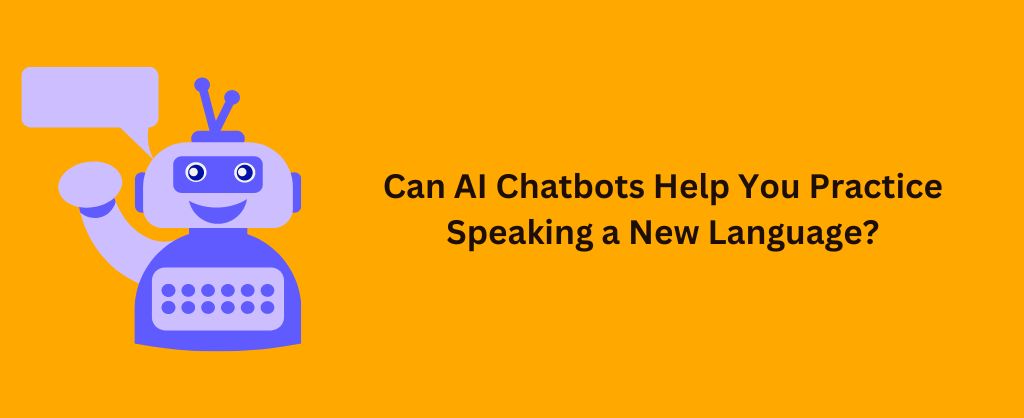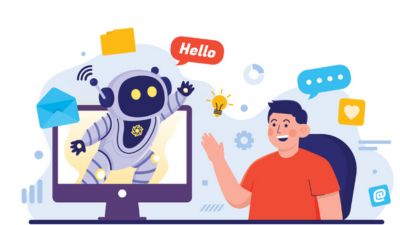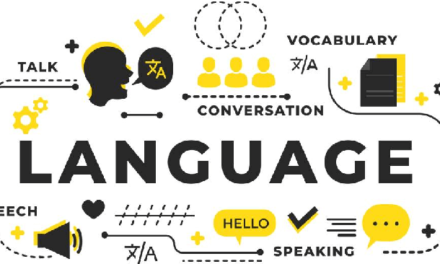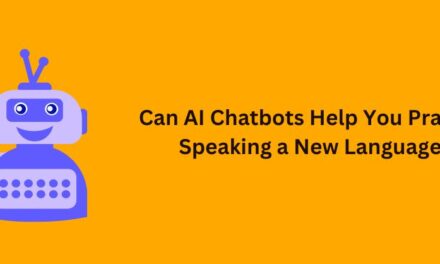Can an AI Chatbot Help You Learn a New Language?

If you’ve ever tried to learn a foreign language, you know how frustrating it can be. I’ve studied Spanish on and off for years, and it’s a constant struggle to practice speaking, keep up with grammar rules, and learn more vocabulary. I wish I had an expert tutor to chat with anytime I wanted to immerse myself in Spanish conversation.
That’s why I got really excited when I heard about chatbots powered by artificial intelligence that are designed specifically for learning languages.
Could chatting with a robot really help improve someone’s Spanish, French, German or Chinese? Let’s take a deeper look at how these AI chatbots work and whether they are worth using to master a new language.
How Exactly Do Chatbots Help With Language Learning?
First, let’s understand how an AI chatbot works. Essentially it’s an intelligent computer program designed to simulate conversation with humans.
Learn Languages Faster with AI Chatbots
Chatbots are programmed using something called natural language processing (NLP) that helps them understand normal human speech and respond appropriately.
Some chatbots are pretty limited and can only handle basic scripted conversations along with some programmed responses. But the most advanced chatbots are integrating deep learning and neural networks so they can comprehend advanced vocabulary, grammar, and sentence structure.
This allows them to have smooth, natural sounding conversations without relying on pre-programmed scripts.
When it comes to learning languages, here are some of the cool capabilities an advanced AI chatbot can provide:
- Converse fluently in the target language: This gives tons of practice for reading, writing, speaking and listening comprehension.
- Offer vocabulary training: The chatbot contains extensive vocabulary on many topics, and can help you strengthen your knowledge.
- Explain grammar concepts: Because it’s programmed with all the grammar rules and structures, the chatbot can clarify how the language works.
- Provide personalized lessons and practice: It assesses your exact abilities to make recommendations on what material to focus on next. The practice it provides is tailored specifically for you.
- Give feedback on your errors: If you make a mistake in grammar, pronunciation or word choice, it can correct you and offer examples so you can learn.
- Assess your progress: Advanced bots can listen to your speaking and writing to evaluate your mastery of concepts.
- Recommend resources: The chatbot can suggest videos, games, apps and more to supplement your learning.
Overall, the conversational nature of interacting with a chatbot provides awesome opportunities to immerse yourself in the language. And having customized lessons and feedback can potentially accelerate your learning.
Why I’m Excited to Use a Chatbot or AI Companion to Learn a Language
After reading up on language learning chatbots, I’m definitely intrigued by their possibilities. Here are some of the key benefits I could see them providing:
Convenient Conversation Practice
One thing I struggle with is finding time to practice Spanish conversation. With a chatbot, I could pull out my phone and start conversing in Spanish any time I have a free moment.
Waiting in line at the store? Chat with my Spanish bot. Laying in bed unable to sleep? More Spanish practice. It’s way more convenient than trying to schedule time with a tutor or language partner.
Personalized Learning Path
In my Spanish studies over the years, I’ve realized I have major gaps. My vocabulary isn’t very broad, and my grammar is shaky in certain areas.
An AI chatbot could assess my abilities, pinpoint those weak spots, and provide lessons and practice tailored to improving those weaknesses. It’s like having an expert tutor identifying targets for growth.
Safe Space to Practice Speaking
As a somewhat shy person, I get self-conscious trying to practice conversing aloud in Spanish. Messing up pronunciation or using the wrong words can be embarrassing.
But a chatbot provides a no-pressure environment where I can work on speaking skills without feeling judged. That will help me gain confidence.
Exposure to Real Language Patterns
I want to learn conversational Spanish that real people use versus stilted textbook language. Sophisticated chatbots incorporate extensive samples of real world vocabulary and grammar patterns.
Chatting with the bot will help me naturally get an ear for authentic language usage.
Fun and Engaging Method
I’ll be honest – drilling vocabulary lists and grammar rules isn’t the most exciting way to learn a language. But conversing with a chatbot could help make the learning process more fun and engaging.
Practicing with AI companions or chatbots feel more like a game than a regular study. Enjoying the practice will motivate me to do it more often.
Cost Effective Alternative to Tutors
Good Spanish tutors charge at least $15 an hour, and I can’t afford that very often. At a fraction of the cost, a chatbot would provide similar benefits of customized instruction and conversation practice.
It’s a budget friendly option compared to human tutoring.
Potential Pitfalls to Watch Out For
At the same time, AI chatbots have some drawbacks I’ll need to be cautious of when using one for language learning. Here are a few key downsides:
Can’t Replace Human Social Intuition
One concern I have is that a chatbot won’t have human social intuition. As advanced as AI is getting, it still can’t completely replicate our innate social capabilities like empathy, humor, and reading emotional cues in conversation.
That may negatively impact the learning experience.
Risk of Incorrect Feedback
While AI chatbots contain extensive language data, there’s always a risk they’ll make mistakes in assessing my abilities or grading my work.
I’ll have to double check any feedback the chatbot provides to be sure I’m not getting led down the wrong path. Relying solely on the bot could reinforce bad habits.
No Cultural Context
Mastering a new language requires more than just memorizing vocabulary lists and grammar rules. There are cultural nuances that are hard to pick up without real human interaction.
A Spanish chatbot won’t be able to explain cultural references, teach slang meanings, or convey subtle connotations the same way a native speaking tutor could.
Technical Limitations
AI definitely has its limitations, especially when interpreting spoken language. Factors like my weak pronunciation, background noise, or the chatbot’s technical deficiencies could hamper our ability to communicate.
I may need to stick to text chatting at first.
Can’t Fully Replace Classroom Learning
As useful as a chatbot may be, I know it can’t fully take the place of classroom instruction and activities. I’ll need to use it as a supplement for practicing what I learn, not as a complete language learning solution.
By being aware of these potential pitfalls, I can make the most of the chatbot’s capabilities while compensating for its limitations using other resources.
Tips for Making the Most of an AI Chatbot for Language Learning
If you decide to use an AI chatbot for helping improve your language skills, here are some tips to maximize the experience:
Start Simple
Don’t jump right into free-flowing conversation. Begin with simple vocabulary practice, short Q&A exchanges, and basic grammar lessons to get comfortable with how the chatbot works.
Once you build a foundation, move to more advanced conversation.
Identify Gaps
Pay attention to subject areas where the chatbot seems to struggle or make odd responses. Make note of those weaknesses so you can fill in gaps using textbooks, apps or a human tutor.
Apply Lessons with Real Humans
Practicing with the chatbot is great, but don’t stop there. Arrange to chat or meet up with native speakers to apply what you learned to conversations with real people.
Use Multiple Resources
Combine your chatbot practice with language learning podcasts, drill apps, instructional videos and other tools for a blended experience. Varying materials will help concepts stick better.
Provide Feedback
Developers use feedback to improve chatbots over time. Share what’s working well and areas that need enhancement so the chatbot can get even smarter.
Don’t Become Too Reliant
As useful as chatbots can be, avoid becoming overly dependent on them. Make sure to engage with human teachers and native speakers regularly for well-rounded language mastery.
Have Fun!
Learning a language requires motivation and engagement. Approach chats with your AI tutor with an open, playful mindset. The more enjoyable the experience, the more progress you’ll make.
Where Chatbots for Language Learning Are Headed
Chatbots for education are still relatively early in development, with lots of untapped potential. Here are just a few ways these AI tutors are likely to evolve in the coming years:
More Human-Like Conversation
As conversational AI keeps advancing, chatbots will become even better at natural, free-flowing dialogue without scripted limitations. The interactions will start feeling more like chatting with a real person.
VR Capabilities
Integration with virtual and augmented reality could allow for practicing language in immersive simulated environments. This would take the experience beyond simple screen-based chatting.
Customization for Learning Styles
More personalization will tailor lessons and conversational style based on how each learner best absorbs information. Visual learners may get more images and videos, while auditory learners get more speech practice.
Gamification
To boost student motivation, game elements may be built into the chatbot experience, like points, levels, challenges and rewards for achieving goals. This will help make language practice more fun.
Social Learning Integration
The ability to connect with other language learners through the chatbot will allow for shared learning experiences like group conversations, tutoring exchanges and team competitions.
Expanded Content
Chatbots will continue building out their capabilities for more languages, topics, vocabulary, slang, dialects, accents and specialized terminology. This will support learning at higher levels.
Should You Start Using an AI Chatbot to Learn a Language?
After researching the possibilities of language learning chatbots, I’m convinced there are some clear benefits that make them worth trying.
However, I know they can’t completely replace human teachers and conversational partners. I believe the ideal solution is combining chatbot practice with formal classroom learning, tutoring and real cultural connections.
For me, the convenience of drilling vocabulary and grammar anytime is extremely appealing. And the prospect of an adaptive program pinpointing my weak spots to make my practice more targeted is really enticing.
While I know the technology still has progress to make, AI chatbots seem to offer unique advantages you just can’t get from traditional language resources.
If you’re looking to seriously improve your foreign language skills, I’d absolutely suggest giving one of these AI tutors a try as part of a mixed approach. Just be sure to set reasonable expectations, be aware of their limitations, and blend them with other learning methods.
As the technology matures over the next several years, chatbots will likely become invaluable tools for mastering languages. Why not start taking advantage now and let a robot help expand your skills?












